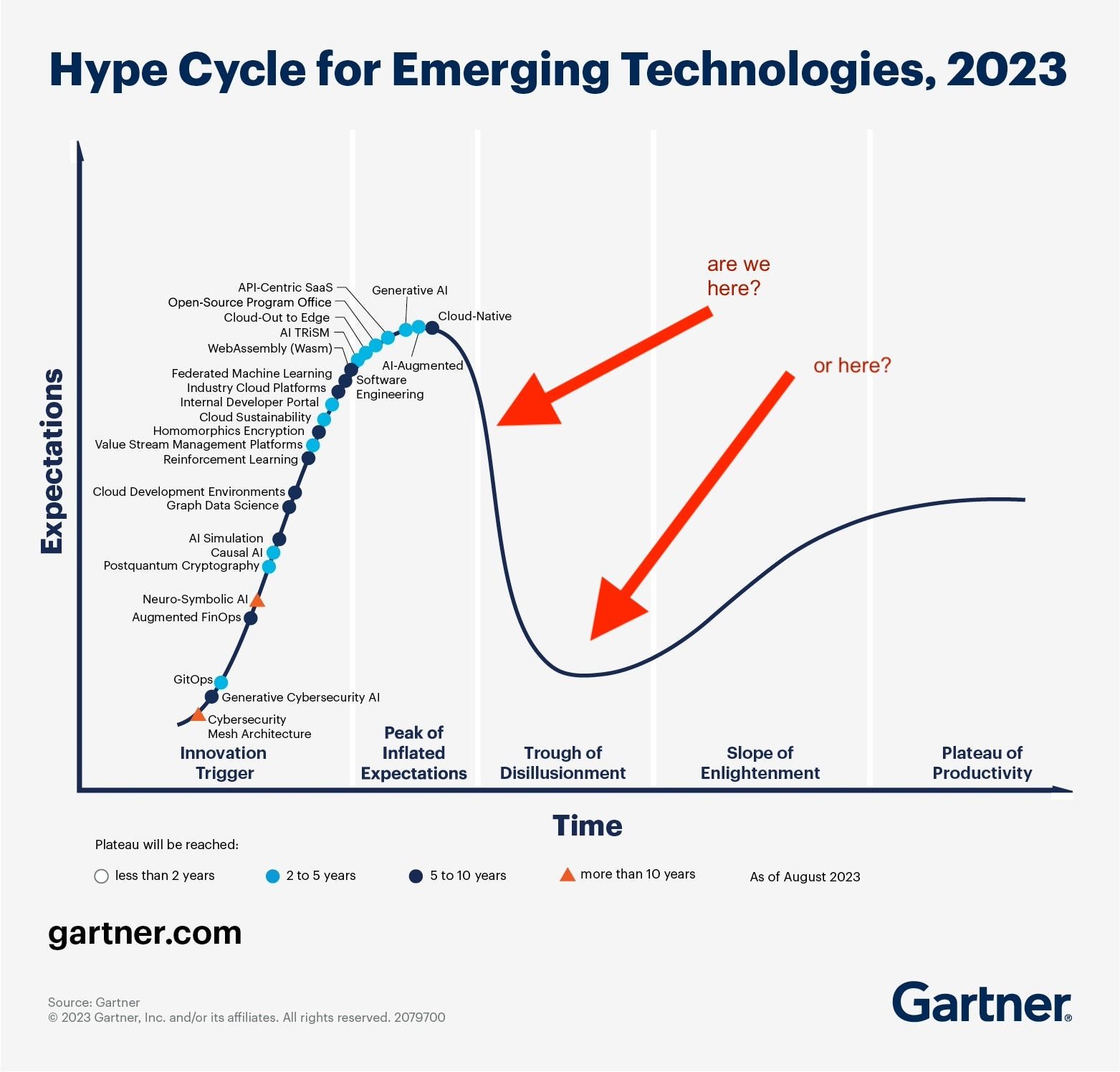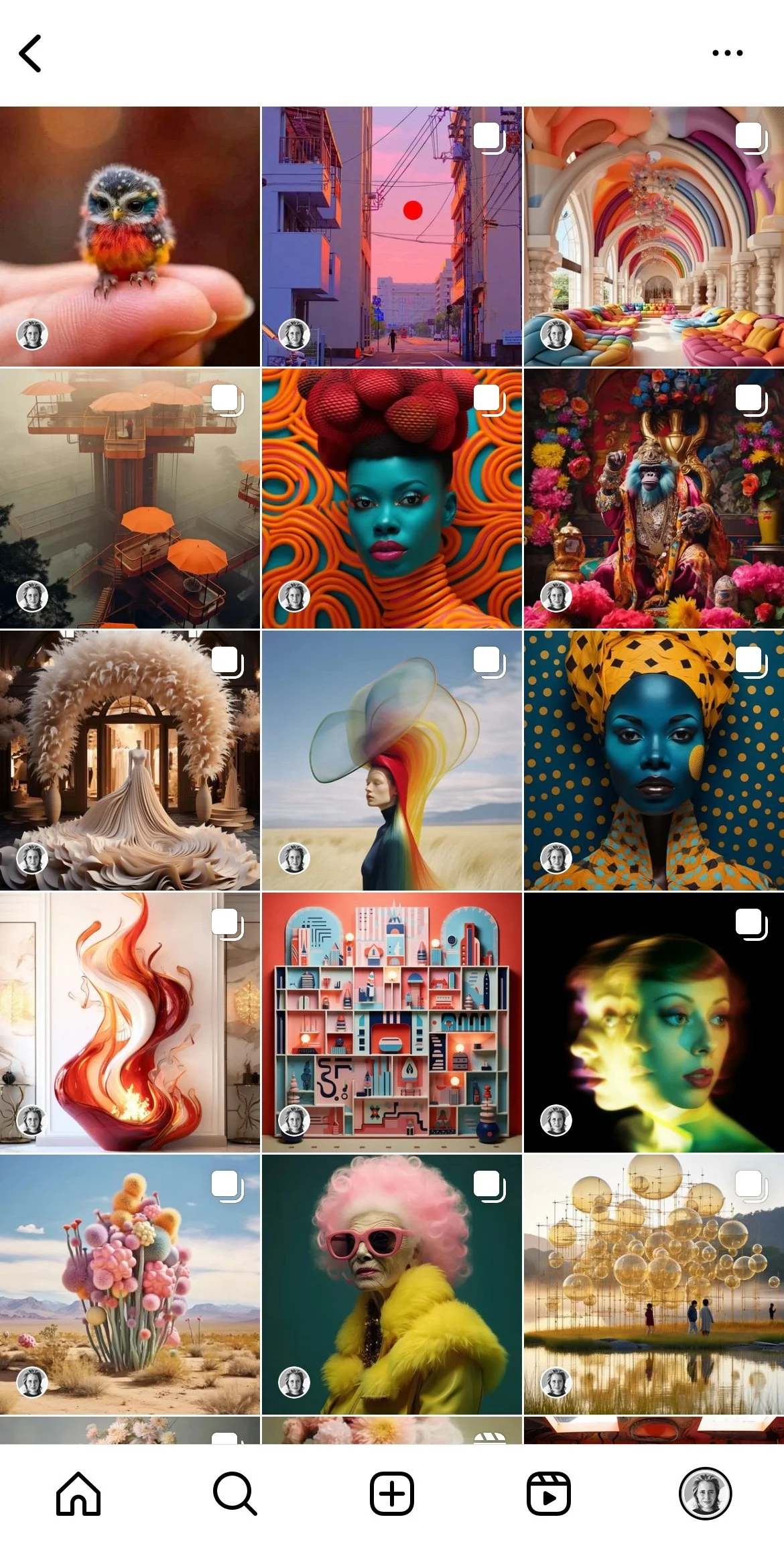AI for Mental Health
Happy President’s Day to all US-based voyagers,
How great is it to have a day off for no reason? Fear not, I’m using my day wisely to write you all, wherever you may be, about artificial intelligence1 and mental health.
“But wait!” you may be saying to yourself, “Isn’t AI the bad guy? Don’t we hate AI?”
Some people certainly do, and many more fear what AI could become, but for now, I’m taking Hamlet’s approach: There is nothing either good nor bad, but thinking makes it so. To me, AI is not a prison.
That said, it’s an easy topic to get sick of. I’m not sure exactly where we are in the current hype cycle around AI, but I know we’ve hovering past the peak of inflated expectations:
For those of you who are sick of AI, I don’t blame you for groaning when you saw this post. I’ll waste no more time and dig into a first way2 you can make AI work for you and your mental health3 :
Use AI to transport your mind to a new place
AI makes visualization exercises much, much easier.
Visualization is a way to transport your mind to a new place. In theory, it’s easy; you just think up a new environment. The hard part comes when you second-guess yourself or your technique, wondering if you’re doing it “the right way.” This is just the sort of thing an overthinker is likely to do, of course, so be aware and try to cut that self-doubt out of the equation before you begin this technique.4
I spent years trying to make simple visualization work for me. I would sit with my eyes closed and try to envision a beach, or the opening of Sound of Music (where the hills were alive). I got a little relaxation from it, but not much, so I added the extra steps in my book to help myself (and you) get specific and focus on the senses. That helped, but it wasn’t until I added AI into the mix that my visualizations started to get really powerful.
My visualization journey started on Instagram, where talented artists like this one were creating new kinds of scenes using generative AI.
At first, I found myself simply being inspired by the new kinds of experimental art I was seeing. I’d always conjured images in my head when reading, but this level of detail was entirely new to me. I started collecting artists and images and calling it “visualization fodder”:
There is no rhyme or reason to my AI visualization feed. I tune into how the image makes me feel in my body when deciding what to save.
And if it had ended there, it would still have been interesting and useful. But it did not end there. One night I awake in the middle of the night and found myself unable to sleep. I start down my usual visualization path (Sound of Music mountains, smell of cut grass, big open skies, singing while twirling, yadda yadda), but it wasn’t working. Instead of continuing to attempt to conjure my own visualizations, instead I began to think of a favorite AI image I had recently seen:
Here’s a link to the account in case you want to explore it yourself.
It reminded me of a kind of perfectly coiffed Peewee’s Playhouse.5 I started to imagine myself walking up the stairs, looking at the orange bushes and pink trees. I concocted a doorbell sound in my ear, and before the front door could open…I was asleep. There was something about the detail in the original image that spurred my creativity — but in a soothing and relaxing way. This is exactly what visualizations are supposed to do.
Step-by-step guide to AI visualization
Start by tuning into how you feel when you see new AI imagery on Instagram or elsewhere. What do you like? How does it feel? What song might go with the place?
Save images that make you feel something — inspired, relaxed, transported. This may not seem like it, but it is an important step. By intentionally saving those feelings that the images are evoking in you, you are building pathways to the feelings for the future.
Choose one of the images you’ve saved, and explore it more in your mind. This could be as simple as imagining what is behind a closed door, or what the cover if a book on a shelf may look like.
When you are next trying to fall asleep, try revisiting that space. You are following a feeling here, folks. It is not easy to do, but as you remember the image that inspired you, try specifically to follow the parts that feel good and let the rest drop away. This can take some practice, but over time, it does work.
Create a greatest hits of your favorite visualizations. These are the ones that you know work. In a way, this is just an updated, more detailed version of counting sheep. The difference is that you are kick-starting the visualization with the creativity of AI.
Getting into a “feeling” state instead of a “thinking” state can be very hard. It took me decades to learn how to shut off my head, and even now, it’s still spotty work. I will use every tool at my disposal to calm my nervous system and mind so that I can be more present for my husband, daughter, friends, and colleagues. This one is working for me—maybe it will for you, too, fellow voyager? Best of all, it is totally free.
Next up in this series: How an AI-drafted writing practice can kickstart your self-discovery. Until then, keep voyaging.
1 I’ll be using the most accessible terms I can in this post. The umbrella term artificial intelligence covers a range of functionality, some of which is still theoretical. This post will focus on generative AI.
2 This is Part 1 of 3. I didn’t want to overwhelm anyone including myself so I’m putting this in a footnote lol.
3 In particular, I’m focused on how AI can help you regulate your nervous system. I could get into lots of detail about why this is important, but I only have part of today to write this, so here’s a place to start if you’re curious.
4 These lines were taken from my first book, Get Out of My Head.
5 I watched a lot, a lot of Peewee’s Playhouse as a kid.




